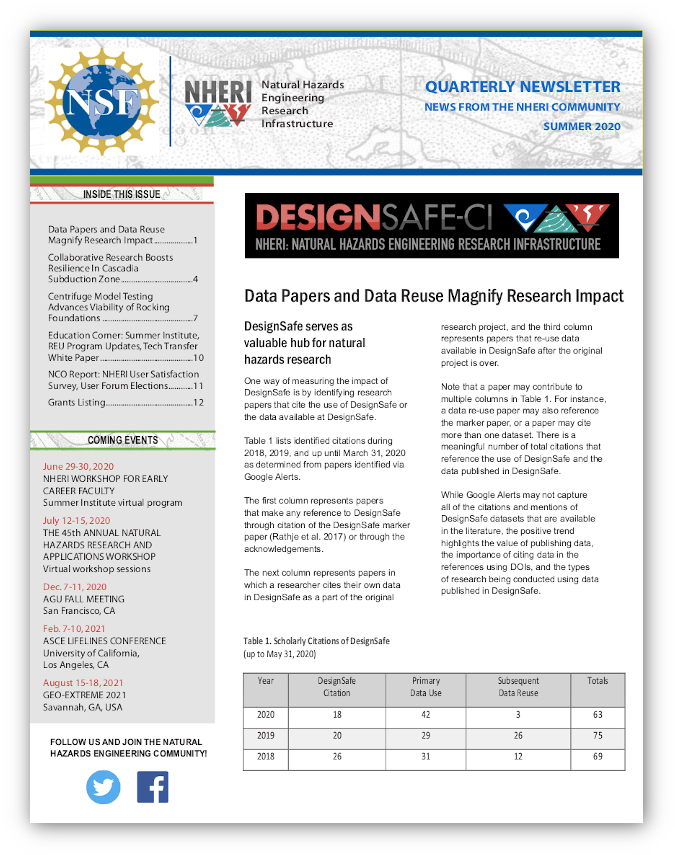Centrifuge Model Testing Advances Viability of Rocking Foundations
Published on June 15, 2020
Model tests on the 1-m and 9-m radius centrifuges at the UC Davis experimental facility demonstrated that rocking foundations could be designed to reduce ductility demands on buildings and bridges during earthquakes.
These experimental data were central to the eventual adoption of code provisions accounting for the benefits and consequences of rocking foundations in practice.
Work spearheaded by NHERI at UC Davis leads to adoption of code provisions
In the past, many building owners and design engineers operated under the notion that a good foundation is one that does not move. But stiff and strong foundations can be expensive.
Research in the last couple of decades has shown that rocking foundations can absorb some of the ductility demand during earthquake loading and can be an economical and effective part of a seismic force resisting system for buildings and bridges.
A rocking foundation is designed to allow significant rotation of a footing during seismic loading; a gap is allowed to develop under the left edge of the footing when it rotates to the right and vice versa the gap cyclically opens and closes, and the footing rocks back and forth.
OVERVIEW
Foundation rocking has two appealing characteristics: a self-centering tendency associated with the gap closure and an energy dissipation capability. However, the fundamental mechanisms and their behaviors for a range of soil and loading conditions was not well understood. In addition, the interactions between inelastic demands in the structural systems and nonlinear rocking demands on the foundations and their potential for accumulated settlement under rocking loads were complicating factors.
Bruce Kutter, principal investigator and director (1996-2009) of the NEES geotechnical centrifuge at UC Davis, notes: A concerted research effort in the international research community over the past 20 years, with centrifuge model testing under NEES and NHERI playing a major role, led to adoption of code provisions accounting for the benefits and consequences of rocking foundations (e.g., ASCE/SEI 2013).

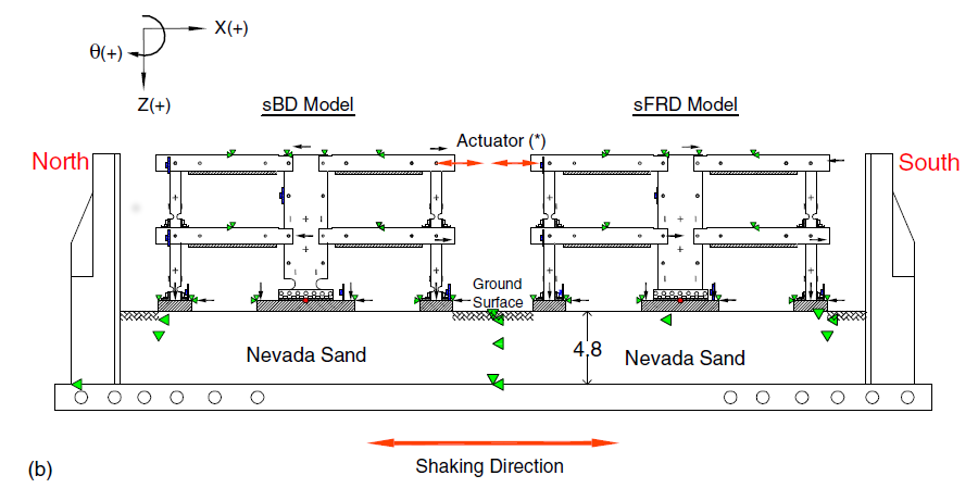
Figure 1. Frame wall-foundation models for testing on the 9-m centrifuge (Liu et al. 2015a)
RESEARCH METHODOLOGY
Large-scale centrifuge models were an essential component of the research studies developing fundamental understanding and validation of analysis methods. One example is the work by Liu et al. (2015a, 2015b). Six different two-story-two-bay, frame-wall-foundation building models resting on dense sand were constructed and tested on the 9-m centrifuge (Figure 1) at the UC Davis facility.
The models represented low-rise structures for which the primary seismic lateral resistance was provided by a shear wall supported on a shallow foundation.
In cases where the moment capacity of the shear wall foundation is greater than the moment capacity of the shear wall itself, a hinge mechanism develops in the shear wall, which is consequently forced to absorb the majority of ductility demand (a hinging-dominated system).
In cases where the moment capacity of the foundation is less than that of the shear wall, the foundation acts as a fuse, and relatively large ductility demands are absorbed by the foundation rocking on soil (a rocking-dominated system).
The six models included two hinging-dominated systems, two rocking-dominated systems, and two balanced systems where the moment capacity of wall and its foundation are similar.
The models were subjected to slow cyclic (pseudo-static) loading in one series of tests, with moment rotation responses for the different components shown in Figure 2, and to dynamic earthquake shaking in another series of tests, with the moment rotation responses shown in Figure 3.
The shallow foundations for the shear walls and frame columns had reasonably well-defined moment rotation responses, consistent with those from a supporting series of tests of single-footing systems on the 1-m radius centrifuge (Hakhamaneshi and Kutter 2016).
The instrumentation consisted of vertical and horizontal accelerometers to define all inertial forces in the structural system and strain gages to define axial, shear, and moments in the key structural components.
The 1-m centrifuge was well-suited for rapid and economical testing of single footings, such that a wide range of footing shapes, sizes, soil types, and loading conditions could be parametrically examined economically.
The 9-m centrifuge, however, was required for constructing the holistic models shown in Figure 1, wherein small connection-scale details (e.g., beam-column plastic hinges), large building-scale frame action, and realistic nonlinear soil-structure interaction play important roles in the system behavior.
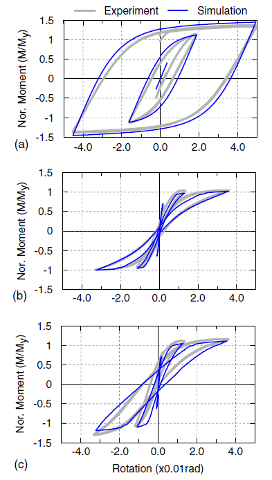
Figure 2. Hysteretic response of inelastic elements in the sFRD model: (a) column fuse at level 2, (b) shear wall rocking footing, and (c) column rocking footing (Liu et al. 2015a)
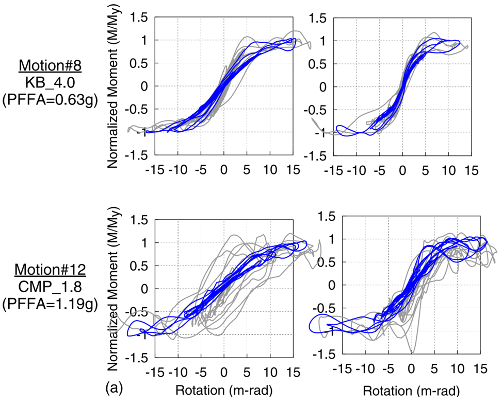
Figure 3. Hysteretic rocking response of shear wall footings during shaking with two for two input motions: measured response based on inverse analyses of sensor data (gray lines) and simulated responses from finite element analyses (blue lines) (Liu et al. 2015b)
PROJECT IMPACT
A common misconception about rocking foundations was that rocking foundations might increase the demand on the structure. The 9-m centrifuge building models showed that rocking foundations, if properly designed, could absorb much of the ductility demand and hence reduce the ductility demand on structural components. The slow cyclic tests on the model buildings demonstrated that the rocking-dominated systems had ductile and stable responses with very little strength degradation, and better re-centering than hinging-dominated systems.
The dynamic earthquake shaking tests at UC Davis by researchers from UC San Diego confirmed that the ductility demand on the shear wall component of the system decreases, and system performance improves, when demand is shifted from wall-hinging to the rocking foundation.
Furthermore, systems with rocking foundations sustained a smaller peak roof acceleration, residual drift, and reduced peak base shear despite the relatively larger peak transient drift demand. Consistent with slow cyclic test results, dissipated hysteretic energy was reasonably distributed amongst superstructure and substructure inelastic components if the capacity of the wall and its foundation are balanced (Figures 2 and 3).
These centrifuge models, with their holistic systems-level details, provided unique experimental data that was the basis for validating the ability of numerical simulation procedures to approximate nonlinearity in the structure and foundation. Numerical simulations showed comparable local and global response to measurements obtained during the experiments.
FOUNDATION ROCKING: OTHER OUTCOMES
Centrifuge model experiments like those described above, along with those performed by others (e.g., a set of companion tests on the NHERI outdoor shaking table at UC San Diego and 9-m radius at UC Davis; Figure 4) provided the basis for rapid development and implementation of design procedures for practice (Hakhamaneshi et al. 2016).
A Technology Transfer Team of practitioners with geotechnical and structural expertise related to buildings and bridges facilitated the projects impact on practice. From 2009 through 2015, this group of six people contributed significantly, including collaboration on revision of building code provisions that eventually allowed designers to use foundation rocking as an effective mechanism contributing to the seismic performance of buildings per ASCE/SEI 41 (2013, 2017).
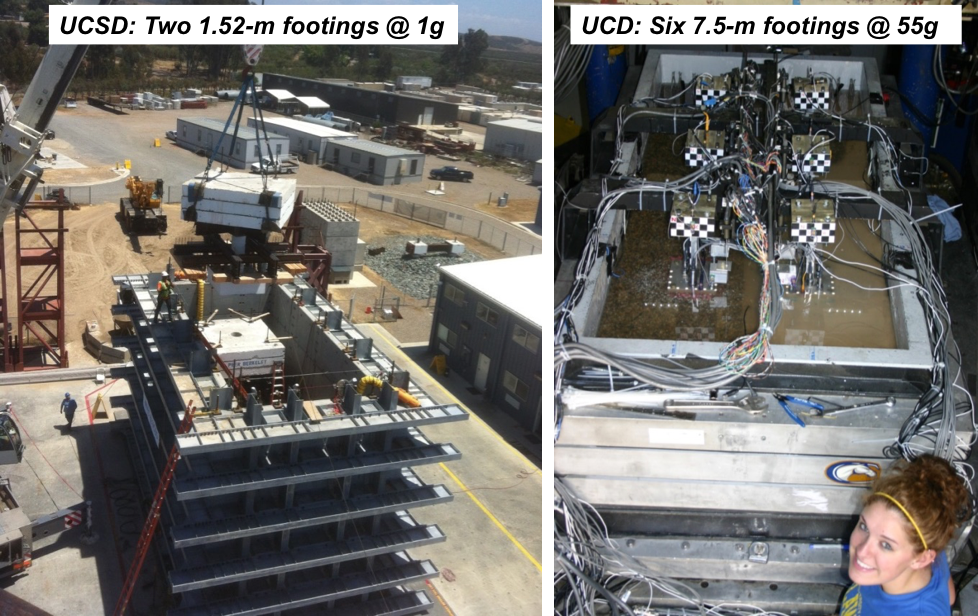
Figure 4. Rocking foundation tests: (a) on the NHERI 1g outdoor shaking table at UC San Diego (Antonellis et al. 2015), and (b) on the NHERI 9-m centrifuge at UC Davis (Allmond and Kutter 2014).
NHERI Quarterly
Summer 2020
Data Papers and Data Reuse Magnify Research Impact
Collaborative Research Boosts Resilience in Cascadia Subduction Zone
Centrifuge Model Testing Advances Viability of Rocking Foundations
Education Corner: Summer Institute, REU Program Updates
New Technical Transfer White Paper Available Online
NCO Report: NHERI User Satisfaction Survey, User Forum Elections
NHERI Grants Listing for Q4 2019 and Q1 2020
